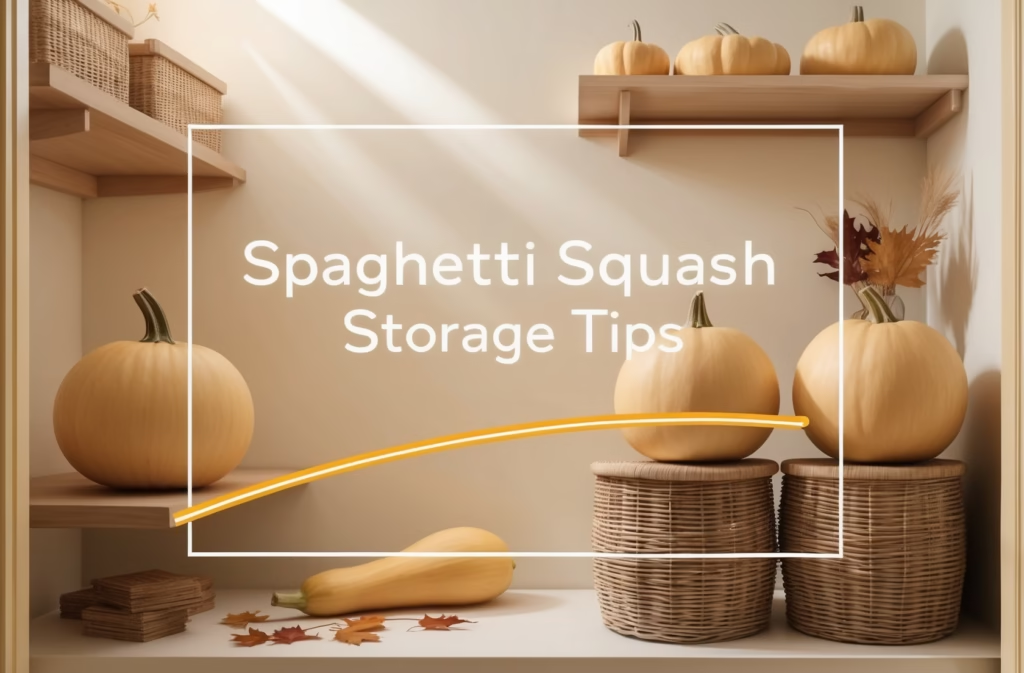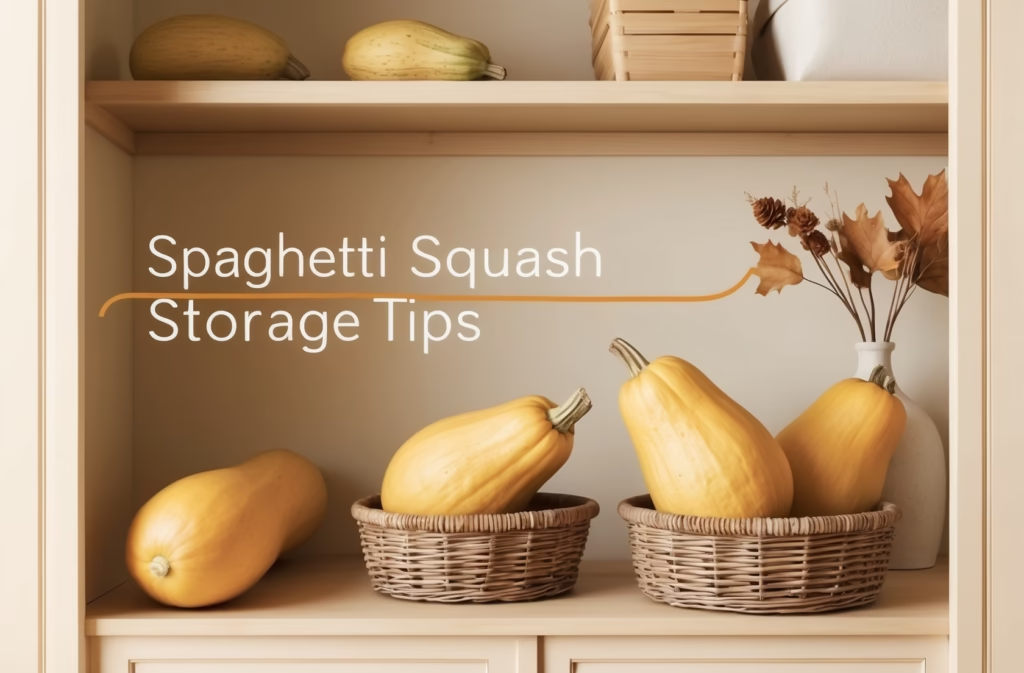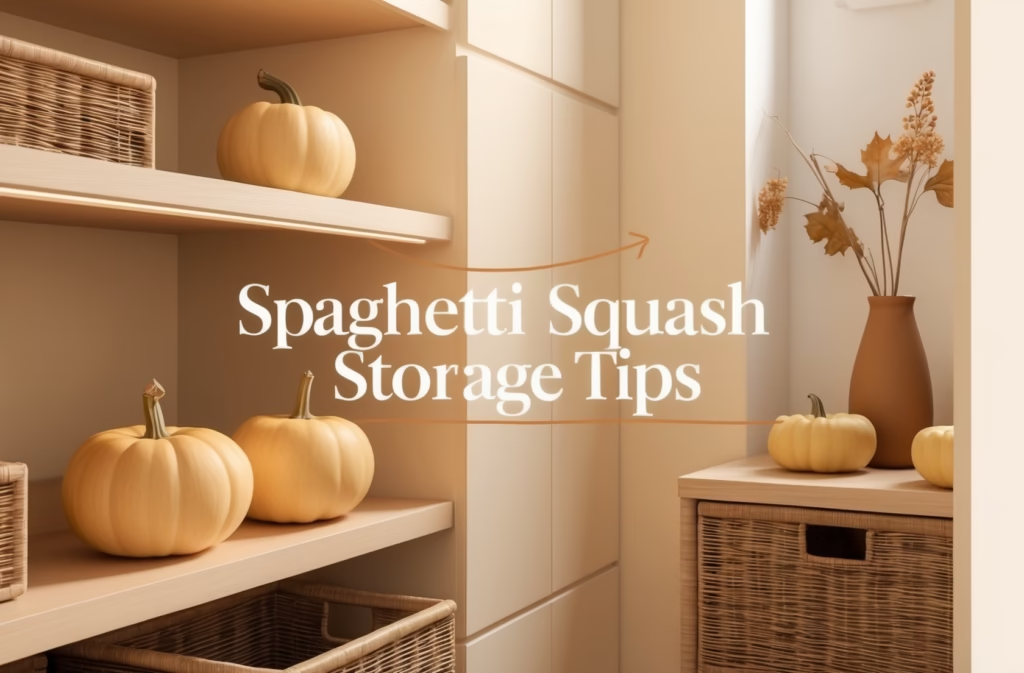How Long Does A Spaghetti Squash Last? Learn about spaghetti squash shelf life & how to store spaghetti squash properly to maximize freshness. Discover expert tips for longer-lasting squash!
How Long Does A Spaghetti Squash Last? A Comprehensive Guide to Spaghetti Squash Shelf Life
Learning how to maximize the shelf life of your produce is a crucial step in reducing food waste and saving money. This comprehensive guide delves into the specifics of spaghetti squash shelf life, exploring how long it lasts in various storage conditions and providing practical tips on how to store spaghetti squash to keep it fresh and flavorful for as long as possible. Whether you’ve just harvested your own spaghetti squash or purchased it from the grocery store, understanding its storage requirements is key to enjoying its delicious, noodle-like texture and nutritional benefits.
Understanding Spaghetti Squash and Its Shelf Life
Spaghetti squash, a winter squash variety, boasts a long shelf life compared to many other vegetables. Its thick skin and relatively low water content contribute to its durability. However, understanding the different stages of its shelf life is essential. The duration your spaghetti squash remains fresh depends significantly on its initial condition and how you store it. A perfectly ripe spaghetti squash, harvested at its peak maturity, will naturally last longer than one that was already starting to deteriorate.
How Long Does A Spaghetti Squash Last at Room Temperature?
A whole, unblemished spaghetti squash can last for several weeks at room temperature, provided it’s stored in a cool, dark, and well-ventilated area. Avoid storing it in direct sunlight or near heat sources, as this can accelerate spoilage. Typically, you can expect a whole spaghetti squash to remain fresh for 2 to 3 weeks at room temperature. However, it’s essential to regularly inspect it for any signs of decay, such as soft spots, mold, or discoloration.
How Long Does a Cut Spaghetti Squash Last?
Once a spaghetti squash is cut, its shelf life dramatically decreases. The exposed flesh is more susceptible to bacterial growth and moisture loss. You should aim to use a cut spaghetti squash within 2 to 3 days if stored in the refrigerator. Wrapping it tightly in plastic wrap or placing it in an airtight container can help extend its shelf life slightly, but it’s best consumed promptly. For longer storage, consider roasting or pureeing the cut squash and freezing it for future use.
How to Store Spaghetti Squash for Optimal Shelf Life
Proper storage is the key to extending the life of your spaghetti squash. Here’s a breakdown of the best methods for storing both whole and cut squash:
Storing Whole Spaghetti Squash:
For whole spaghetti squash, a cool, dry, and dark place is ideal. A pantry or basement is perfect. Avoid placing it near any heat sources or direct sunlight which can cause it to ripen too quickly and spoil sooner. You can also store whole spaghetti squash in a cool and dry area of your refrigerator for up to 2 months; however, room temperature is preferable unless your kitchen environment is unusually warm.
Storing Cut Spaghetti Squash:
Once you’ve cut into your spaghetti squash, refrigeration is essential. Wrap the cut sides tightly in plastic wrap or place the squash in an airtight container to minimize exposure to air. Remember, even with proper refrigeration, you should consume the cut spaghetti squash within 2-3 days.
Freezing Spaghetti Squash:
Freezing is an excellent method for preserving spaghetti squash for extended periods. Roast or steam the squash until tender, then allow it to cool completely before transferring it to freezer-safe bags or containers. Frozen spaghetti squash can last for 8 to 12 months.
Signs Your Spaghetti Squash Has Gone Bad
It’s crucial to know the signs of spoilage to avoid consuming a bad spaghetti squash. Discard your squash if you notice any of the following:
- Soft spots or mushy areas: This indicates bacterial growth or decay.
- Mold: Any visible mold is a clear sign of spoilage.
- Unpleasant odor: A sour or foul smell signals that the squash has gone bad.
- Discoloration: Significant changes in color, especially darkening or browning, are often indicators of spoilage.
Recipes to Use Up Your Spaghetti Squash Before it Spoils
To ensure you don’t let your spaghetti squash go to waste, plan your meals around its shelf life. Here are a few recipe ideas to inspire you:
For a comforting and delicious meal, try our spaghetti squash casserole. This hearty dish is perfect for a chilly evening.
If you are looking for a lighter option, consider incorporating the squash into a fresh salad. Check out our recipe for a harvest salad with butternut squash for inspiration – this can easily be adapted to include spaghetti squash. Though it mentions butternut squash, the concept is easily adaptable.
For something a bit sweeter, you can experiment with the butterscotch squash recipe. This recipe can be adapted to use spaghetti squash too.
Extending the Shelf Life of Other Winter Squashes
The principles of storing spaghetti squash apply to other winter squashes like butternut squash, acorn squash, and kabocha squash. Proper storage – cool, dry, and dark – is vital for all these varieties. Remember to inspect them regularly for signs of spoilage. If you’re looking for alternative recipes to use up your winter squashes, you might be interested in trying stuffed zucchini boats or stuffed eggplant which utilize similar cooking principles.
External Resources for Further Information on Vegetable Storage
For more in-depth information on vegetable storage and preservation, you can consult resources like the USDA Food Safety and Inspection Service, which provides comprehensive guidelines on food safety and storage. You can also check out the StillTasty website which is a great resource for checking the shelf life of different foods.
Conclusion: Mastering Spaghetti Squash Storage
Understanding how long does a spaghetti squash last depends heavily on its condition and how you store it. By following the tips outlined in this guide, you can significantly extend the shelf life of your spaghetti squash and minimize food waste. Remember to inspect your squash regularly for signs of spoilage and to utilize it creatively within its optimal timeframe. With a little knowledge and careful planning, you can enjoy this nutritious and versatile vegetable for weeks after bringing it home.
Now it’s your turn! Share your experiences and tips on storing spaghetti squash in the comments below. What are your favorite recipes using spaghetti squash? Let’s discuss and learn from each other!

Frequently Asked Questions: Spaghetti Squash Shelf Life
- How long does a spaghetti squash last at room temperature?
- A whole, uncut spaghetti squash will last for about a week at room temperature, but its quality will start to decline. For optimal flavor and texture, it’s best to refrigerate or use it sooner.
- How long does a cut spaghetti squash last in the refrigerator?
- Once cut, a spaghetti squash should be refrigerated. Properly stored, cut pieces will last for 3-5 days. The spaghetti squash shelf life is significantly reduced once it’s been cut.
- How long does a cooked spaghetti squash last in the refrigerator?
- Cooked spaghetti squash, stored in an airtight container, will last for 3-4 days in the refrigerator. Make sure it’s completely cooled before storing to prevent bacterial growth.
- Can I freeze spaghetti squash?
- Yes, you can freeze both cooked and uncooked spaghetti squash. Freezing significantly extends its shelf life. Uncooked squash can last for 8-12 months, while cooked squash will last for 6-8 months. Blanching before freezing is recommended for optimal quality.
- What are the signs that my spaghetti squash has gone bad?
- Signs of spoilage include mushy texture, mold, unpleasant odor, or slimy areas. Discard any spaghetti squash showing these signs, regardless of how long it’s been stored.
- How to store spaghetti squash for the longest shelf life?
- For the longest shelf life, store whole, uncut spaghetti squash in a cool, dry, and dark place. Refrigerate cut or cooked squash in an airtight container. Freezing is the best method for long-term storage.
- What is the average spaghetti squash shelf life?
- The average spaghetti squash shelf life depends on storage methods. Uncut, it lasts about a week at room temperature. Refrigerated, cut pieces last 3-5 days and cooked for 3-4 days. Freezing extends this to 6-12 months.
- How can I tell if my spaghetti squash is still good?
- Check for firmness. A good spaghetti squash will feel hard and heavy. Avoid squash that is soft, bruised or has any discoloration. Smell it; a bad squash will have a foul odor.
- Does the spaghetti squash shelf life vary by variety?
- While there might be slight variations between varieties, the general guidelines for spaghetti squash shelf life remain consistent across different types. Proper storage techniques are key regardless of the variety.
- My spaghetti squash is slightly soft, is it still safe to eat?
- If your spaghetti squash is only slightly soft and shows no other signs of spoilage (mold, unpleasant odor), it may still be safe to eat. However, it’s best to cook it thoroughly and check carefully for any undesirable changes in texture or smell before consumption. When in doubt, throw it out.

How Long Does a Spaghetti Squash Last? A Comprehensive Guide to Shelf Life and Storage
Spaghetti squash, with its unique texture and mild flavor, has become a popular staple in many kitchens. But how long does this versatile squash actually last? Understanding the spaghetti squash shelf life and how to store spaghetti squash properly is key to avoiding waste and maximizing its delicious potential. This comprehensive guide will answer your burning questions, providing tips and tricks for keeping your spaghetti squash fresh and flavorful for as long as possible.
How Long Does a Spaghetti Squash Last? Understanding Shelf Life
The answer to how long does a spaghetti squash last depends largely on how you store it. A whole, uncooked spaghetti squash can last for quite a while, while a cooked or cut squash has a much shorter shelf life. Let’s break it down:
Whole, Uncut Spaghetti Squash:
A whole, uncut spaghetti squash, stored properly in a cool, dry place like a pantry or root cellar, can typically last for 2 to 3 months. Choose squashes that are firm, without bruises or soft spots. Avoid squashes with cuts or blemishes, as these are entry points for spoilage.
Cut or Cooked Spaghetti Squash:
Once you’ve cut into a spaghetti squash, its shelf life dramatically reduces. Refrigerated, cut spaghetti squash should be used within 3 to 5 days. Cooked spaghetti squash, similarly, should be consumed within 3 to 4 days when stored properly in an airtight container in the refrigerator. To extend its life a little, you can freeze cooked spaghetti squash (see below).
How to Store Spaghetti Squash: Maximizing Shelf Life
Proper storage is crucial to prolonging the spaghetti squash shelf life. Here’s how to store both whole and cut spaghetti squash:
Storing Whole Spaghetti Squash:
For optimal storage, place your whole, uncut spaghetti squash in a cool, dark, and dry place. A pantry, root cellar, or even a cool basement are ideal locations. Avoid storing them near fruits, which release ethylene gas that can accelerate ripening and spoilage. Storing them at room temperature is best for longevity, until you’re ready to cook.
Storing Cut Spaghetti Squash:
Cut spaghetti squash should be refrigerated immediately. Wrap the cut surfaces tightly in plastic wrap or place them in an airtight container to prevent moisture loss and bacterial growth. Remember, the goal is to minimize exposure to air.
Freezing Spaghetti Squash:
Freezing cooked spaghetti squash is a great way to extend its shelf life. After cooking, allow it to cool completely. Then, you can store it in freezer-safe bags or containers for up to 3 months. When using frozen squash, remember to thaw it completely before reheating.
Signs Your Spaghetti Squash Has Gone Bad
It’s important to know how to identify spoiled spaghetti squash. Discard your squash if you notice any of the following:
- Soft spots or mushy areas
- Mold growth
- An unpleasant odor
- Significant discoloration or browning
Delicious Recipes Using Spaghetti Squash
Once you’ve mastered the art of how to store spaghetti squash, you can unleash its culinary versatility! Here are some ideas to inspire your cooking:
For a comforting and hearty dish, try our Spaghetti Squash Casserole. It’s a perfect autumnal meal that’s both healthy and delicious. If you are looking for a lighter option, consider adding spaghetti squash to a vibrant Harvest Salad with Butternut Squash, or try our Butterscotch Squash recipe for a unique dessert. For those looking for alternative vegetable recipes, you can also try Stuffed Zucchini Boats or Stuffed Eggplant.
Looking for more ideas? Check out this helpful article on how to cook spaghetti squash from EatingWell. Or explore even more squash recipes on Allrecipes.
Spaghetti Squash Nutrition Facts (Per 1-cup Serving of Cooked Spaghetti Squash)
The following nutrition information is an approximation and may vary based on specific preparation methods and the size of the spaghetti squash.
| Nutrient | Amount per Serving | % Daily Value (2,000 calorie diet) |
|---|---|---|
| Calories | 42 | 2% |
| Protein | 2g | 4% |
| Total Fat | 0.2g | 0.3% |
| Saturated Fat | 0g | 0% |
| Unsaturated Fat | 0.2g | – |
| Trans Fat | 0g | 0% |
| Carbohydrates | 10g | 3% |
| Dietary Fiber | 2g | 8% |
| Sugars | 2g | – |
| Vitamin C | 10mg | 11% |
| Vitamin A | 137mcg | 15% |
| Potassium | 235mg | 5% |
| Magnesium | 22mg | 5% |
| Manganese | 0.2mg | 10% |
Summary of Nutritional Highlights
Spaghetti squash is a low-calorie, nutrient-rich vegetable. It’s an excellent source of dietary fiber, which is beneficial for digestion and gut health. It also contains various vitamins and minerals, including vitamins C and A, and potassium. The low calorie count and high fiber content make it a great choice for weight management and overall health.
Try it and Share!
Now that you’re a spaghetti squash expert, armed with knowledge on how long does a spaghetti squash last and the best storage techniques, it’s time to get cooking! Try one of the delicious recipes above, and don’t forget to share your culinary creations on social media using #SpaghettiSquashPerfection! We’d love to see your photos and hear about your experience. Leave a comment below and let us know what you think!

How Long Does a Spaghetti Squash Last? A Guide to Storage and Health
Spaghetti squash, with its unique texture and versatility, is a delicious and nutritious addition to any meal. But knowing how long it lasts is crucial to avoid waste and ensure you’re enjoying it at its peak. Proper storage significantly impacts the shelf life of your squash. A whole, uncooked spaghetti squash can last for several weeks in a cool, dark, and dry place. Think of it like storing pumpkins or other winter squash. However, once you cut into it, things change dramatically.
Cut spaghetti squash should be refrigerated immediately. Even then, it will only last for about 3-5 days in the crisper drawer. After this time, it’s likely to start showing signs of spoilage, such as softening, discoloration, or a musty odor. To maximize its lifespan, wrap the cut portions tightly in plastic wrap or place them in an airtight container. This helps to prevent moisture loss and bacterial growth. Remember, you can use leftover cooked spaghetti squash in a variety of delicious recipes, like this hearty spaghetti squash casserole to avoid waste.
Health Considerations: Spaghetti squash is a low-calorie, nutrient-rich vegetable packed with vitamins, minerals, and fiber. However, consuming spoiled squash can lead to foodborne illnesses. Always inspect your squash carefully before using it. If it exhibits any signs of decay, discard it immediately. The same careful storage applies to other winter squash as well, though their uses vary. For instance, butternut squash can be used in a delicious harvest salad, demonstrating its versatility. If you are looking for alternative squash recipes, you may want to try something completely different like butterscotch squash for a sweet treat.
Freezing for Extended Storage: For longer storage, consider freezing your cooked spaghetti squash. Simply puree or chop the cooked squash and freeze it in airtight containers or freezer bags. Frozen cooked spaghetti squash can typically last for 2-3 months. This allows you to enjoy its benefits throughout the year. If you run out of squash ideas, consider alternative hearty meals like stuffed zucchini boats or stuffed eggplant which also offer similar nutritional benefits.
In summary, understanding the shelf life of spaghetti squash ensures you get the most out of this healthy and delicious vegetable. Proper storage and timely consumption are key to preventing food waste and enjoying its nutritional benefits. Remember to always prioritize food safety.